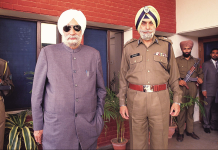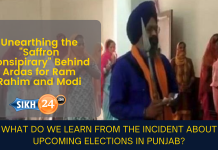This is not just a film review. It is a defence of the Khalistan movement, its philosophy, and its past leadership which is wrongfully depicted within Punjab 1984…it is nothing less and nothing more.
The sangarsh (revolution) that arose in Punjab after June 1984 was and still IS the Khalistan movement. It was no longer a movement for the Anandpur Sahib resolution (greater autonomy for the Punjab state by de-centralizing power and having Punjab remain part of modern day India), it was not a movement for obtaining justice for human rights violations committed against the Sikh people and nor was it a movement for religious separation of the Sikh people from non-Sikhs around them. Quite bluntly, this movement was and still is the rightful separation of Punjab from India and the re-establishment of Punjab as its own country where Punjabis can live in relative peace while ensuring the successful transfer of the Punjabi language (Gurmukhi lipi), Punjabi culture, and—for the would be Sikh majority population—the Sikh way of life to coming generations while securing themselves from the communal politics of Delhi.
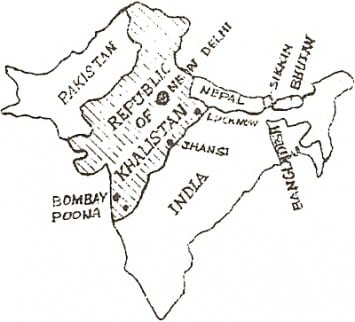


This is a sangarsh. If I may, I take great offence on behalf of my shaheed brothers and sisters who are often depicted as imbeciles and revenge seeking traitors within Indian cinema (including Punjabi cinema). For someone like me, it is difficult to look at quality of acting, production, etc. if there are fundamental flaws in the representation of an entire movement and Punjab 1984 is flawed beyond a doubt in its portrayal of Khalistan, Khalistani leadership of the past, and our Jujharoo (Resistance Fighters) shaheeds. If the notion of Khalistan was not going to be supported, then the film makers should expect a reaction from the pro-Khalistan elements of the Sikh community when such a poor representation is provided both in action and intellect of Jujharoos. It is more difficult to reason why those who are pro-sangarsh feel the need to try and justify this film which shows Khalistanis as nothing more than idiotic bloodthirsty stooges who can be manipulated at will by either side of the border, with the usual exception of one main character who seems to be the only one with a moral code.
Our job as individuals who are pro-sangarsh is to promote and move the sangarsh and not to promote “celebrities” and think that we are using them, when it is almost always the opposite. The sangarsh needs those who have established through “khoj” (research) solid foundations and can think for themselves, not drones who will fall apart beyond surface questioning. If the film industry is not ready for or we as a nation are not prepared to produce films that depict Khalistan and Khalistani leadership within the right context then we must engage our people in other ways. We have always been the few and strong and there is nothing wrong with that, especially if gaining numbers is accomplished at the wrongful depiction of those who did not leave their homes for revenge, but rather left for the love of their Panth and the protection of the Gurus’ path:
ਕਬੀਰ ਜਿਹ ਮਾਰਗਿ ਪੰਡਿਤ ਗਏ ਪਾਛੈ ਪਰੀ ਬਹੀਰ ॥
Kabīr jih mārag pandiṯ gae pācẖẖai parī bahīr.
Kabeer, crowds of ill-informed people follow the path which the Pandits (religious scholars) have wrongfully provided.ਇਕ ਅਵਘਟ ਘਾਟੀ ਰਾਮ ਕੀ ਤਿਹ ਚੜਿ ਰਹਿਓ ਕਬੀਰ ॥੧੬੫॥
Ik avgẖat gẖātī rām kī ṯih cẖaṛ rahio Kabīr.
There is a difficult and treacherous cliff on that path to the Lord; Kabeer (and those not a part of this “mob”) is climbing that cliff.This “baheer” (crowd) is dangerous for us in all aspects of our life (social peer pressure, religious instruction, cultural “norms”, etc.) including the sangarsh. Once this “baheer” begins to move, it then dictates its own reality:
ਨਾਉ ਫਕੀਰੈ ਪਾਤਿਸਾਹੁ ਮੂਰਖ ਪੰਡਿਤੁ ਨਾਉ ॥
Nāo fakīrai pāṯisāhu mūrakẖ pandiṯ nāo.
The beggar is known as an emperor, and the fool is known as a religious scholar.ਅੰਧੇ ਕਾ ਨਾਉ ਪਾਰਖੂ ਏਵੈ ਕਰੇ ਗੁਆਉ ॥
Anḏẖe kā nāo pārkẖū evai kare guāo.
The blind man is known as a seer; and the “people” give testimony to this.ਇਲਤਿ ਕਾ ਨਾਉ ਚਉਧਰੀ ਕੂੜੀ ਪੂਰੇ ਥਾਉ ॥
Ilaṯ kā nāo cẖauḏẖrī kūṛī pūre thāo.
The trouble-maker is called a leader, and the liar is seated with honor.ਨਾਨਕ ਗੁਰਮੁਖਿ ਜਾਣੀਐ ਕਲਿ ਕਾ ਏਹੁ ਨਿਆਉ ॥੧॥
Nānak gurmukẖ jāṇīai kal kā ehu niāo.
Guru Nanak says, the Gurmukhs know that this is seen as justice in Dark Times.
To me this is no small issue and is not easily swept away by even those who are pro-sangarsh and in favor of this movie. One of the reasons this happens is because we have started accepting “good enough” if it gets “our message” across.
What message?
When no context is provided to anything, a movie like Punjab 1984 becomes an emotionally distressful depiction of the very real sorrows of Punjab and its citizens while de-humanizing and criminalizing those who lived and died for the sangarsh. So are we satisfied with the inseparable messages that will be promoted via this film? Namely that June 1984 and the human rights violations in Punjab were bad and people on both sides suffered AND the fact that apparently the Khalistan movement was led by violent criminal types who would stoop to anything (including the murder of innocents) to accomplish their goal as laid out for them by foreign powers whether in Delhi or Islamabad?
The emotion of tremendous loss suffered by the people of Punjab during this time is enough to make anyone tear up, but beyond that emotion, which has been used as a tool of emotional blackmail against this community time and time again, what other messages are being provided?
In the entire film there is not one Khalistan Jathebandi leader who is shown in a positive light. One “Sukhdev Singh” leading the main character “Shivjit Singh” (Diljit Dosanjh), is depicted as a psychopathic blood-thirsty maniac who is actually a government operative (referred to as “black cats”) in Sikh garb. Then there is the depiction of a sly old politician (Badal type) who drinks and repeatedly reminds everyone that a “hathyaar-bandh sangarsh” (armed resistance) will be futile and dialogue with the state is necessary and all the while he too is a government operative causing chaos in the name of Khalistan for his own gain.
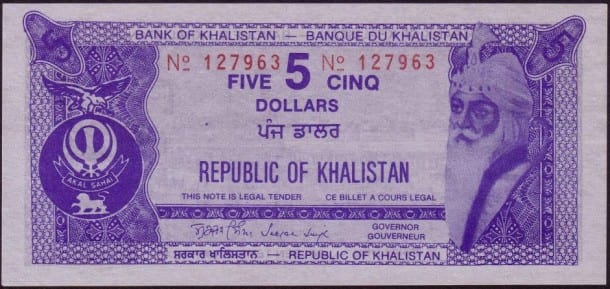


At a “conference” of Khalistani leaders in the film, the leaders are shown as screaming at one another and it is at this point where a Singh is introduced as somewhat of a “clean” Khalistani leader. The issue with this is that even he is justifying the murder of innocent Hindus pulled off a bus from the scene before. It gets even worse as he quotes a line attributed to Rajiv Gandhi “when a big tree falls, the earth is bound to shake” as the justification for the murder of these innocents—the same quote used by Rajiv Gandhi to explain the November 1984 genocide of Sikhs across India after the assassination of his mother Indira Gandhi at the hands of Bhais Beant Singh, Satwant Singh, and Kehar Singh due to Indira Gandhi orchestrating and ordering the attack on Darbar Sahib in June 1984.
This leader is very soon thereafter shot dead by “black cats” posing as Khalistanis who were involved in the bus massacre from a few scenes prior. Nowhere in the entire movie is there any context provided to “black cats” and their role in defaming the Khalistan movement, so how is it expected that the audience will pick up on this if they are new to the topic? The issue of the Khalistan movement cannot be captured in 3 hours or less, so why try? Saying that this movie shows a mother’s story is completely inaccurate because then the kharku sangarsh should have not been depicted and the story should stick to a mother searching for her son who is made to disappear.
The question is not whether people like the aforementioned existed (they probably did), or if wrong things happened in the sangarsh (unfortunately they probably did, as it does in every movement), but rather where is the other side in this depiction?
No single act committed in the name of a revolution can be indicative of the aspirations of an entire nation of people and the philosophy behind that revolution. Khalistan is NOT sought after by the Sikh nation as a motive of revenge and nor should the Khalistani leadership of that time be portrayed in such a way.
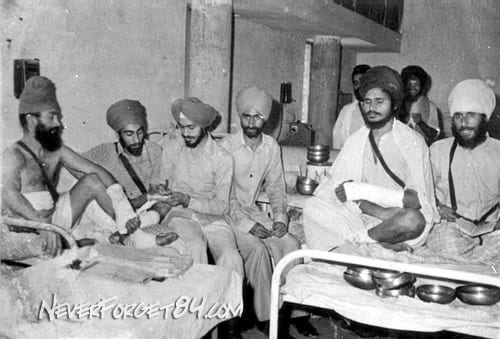


Show me where is the steadfastness and chardi kala of Baba Gurbachan Singh Manochahal being depicted as he marched with 100 Sikhs with Bhai Fauja Singh in 1978 to stop the Narakdhari Baba—leader of a government sponsored cult which openly challenged the Sikh way of life and authority of Sri Guru Granth Sahib ji—while reciting Gurbani and being shot in the process?
Where is the fearlessness of Jathedars Avtar Singh Brahma and Gurjant Singh Budhsinghwala being depicted when calling out corrupt and murderous Police Officers from the speakerphones in the pinds (villages) of Punjab?
Where is the courage of General Labh Singh and Manbir Singh Chaheru in 1986 when Bhai Chaheru risks everything for his fellow revolutionary and attacks a police station to have General Labh Singh released?
Where is the spirituality and Sikhi parchar of Jathedars Talwinder Singh Babbar and Sukhdev Singh Babbar being depicted as they were part of a Jathebandi that was pro-Khalistan from well before the June 1984 attack on Darbar Sahib and not tools in the hands of some foreign power?
These were some of the greatest leaders of the Khalistan movement and it was through them that our generation has received its greatest inspiration in the modern sense. It was the upholding of the truth, the struggle for rights and committing to the sacrifice of mind, body, and soul for its accomplishment that the mission of the Guru could be seen being delivered through their Sikhs:
Sikh Guru, Guru Sikh hai ekai.
Gur Updes Chalaye.
The Sikh is one with and a reflection of the Guru,
But only those Sikhs who move forward the mission of the Guru.
Simply showing some of the bad qualities of leadership and ignoring some of the most beautiful and powerful souls of our generation is a complete disservice to their memory and this movement. Because if they were shown, then the message of a true Khalistani Jujharoo and Khalistani Leadership as provided to the President of India by Bhai Harjinder Singh Jinda and Bhai Sukhdev Singh Sukha would have rang through the entire film as an underlying theme:
“Through you we also wish to transmit this message that we harbor no enmity to the people and land of India. We are not touched even a bit by hatred for the people of India. We are not only restless to embrace our own people, but rather we are restless to embrace the whole of the earth and the sky. We intoxicatedly remember the entire cosmos and worship the life that vibrates in it.”
(Shaheed Bhai Jinda & Sukha)
KHALISTAN ZINDABAD

